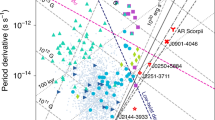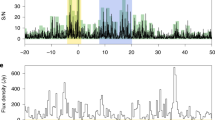Abstract
On the 50th anniversary of the accidental discovery of pulsars (pulsating radio stars, also known as neutron stars) I reflect on the process of their detection and how our understanding of these stars gradually grew. Fifty years on, we have a much better (but still incomplete) understanding of these extreme objects, which I summarize here. The study of pulsars is advancing several areas of fundamental physics, including general relativity, particle physics, condensed-matter physics, and radiation processes in extreme electric and magnetic fields. New observational facilities coming online in the radio regime (such as the Five hundred meter Aperture Spherical Telescope and the Square Kilometre Array precursors) will revolutionize the search for pulsars by accessing thousands more, thus ushering in a new era of discovery for the field.
This is a preview of subscription content, access via your institution
Access options
Access Nature and 54 other Nature Portfolio journals
Get Nature+, our best-value online-access subscription
$29.99 / 30 days
cancel any time
Subscribe to this journal
Receive 12 digital issues and online access to articles
$119.00 per year
only $9.92 per issue
Buy this article
- Purchase on Springer Link
- Instant access to full article PDF
Prices may be subject to local taxes which are calculated during checkout

Graham Woan.


SKA South Africa.

Dr Natasha Hurley-Walker, Curtin Institute of Radio Astronomy International Centre for Radio Astronomy Research.

NAOC.
Similar content being viewed by others
References
Hewish, A., Bell, S. J., Pilkington, J. D. H., Scott, P. F. & Collins, R. A. Observation of a rapidly pulsating radio source. Nature 217, 709–713 (1968).
Gold, T. Rotating neutron stars and the nature of pulsars. Nature 221, 25–27 (1969).
Caraveo, P. Gamma-ray pulsar revolution. Annu. Rev. Astron. Astr. 52, 211–250 (2014).
Kramer, M. & Stairs, I. H. The double pulsar. Annu. Rev. Astron. Astr. 46, 541–572 (2008).
Wolszczan, A. & Frail, D. A planetary system around the millisecond pulsar PSR1257+12. Nature 336, 145–147 (1992).
Ransom, S. M. et al. A millisecond pulsar in a stellar triple system. Nature 505, 520–524 (2014).
Kaspi, V. M. & Beloborodov, A. M. Magnetars. Annu. Rev. Astron. Astr. 55, 261–301 (2017).
McLaughlin, M. A. et al. Transient radio bursts from rotating neutron stars. Nature 439, 817–820 (2006).
Wijnands, R. & van der Klis, M. A millisecond pulsar in an X-ray binary system. Nature 394, 344–346 (1998).
Muslimov, A. G. & Harding, A. K. The effects of rotation and relativistic charge flow on pulsar magnetospheric structure. Astrophys. J. 630, 454–464 (2005).
Demorest, P. B. et al. A two-solar-mass neutron star measured using Shapiro delay. Nature 467, 1081–1083 (2010).
Espinoza, C. M. et al. A study of 315 glitches in the rotation of 102 pulsars. Mon. Not. R.Astron. Soc. 414, 1679–1704 (2011).
Geyer, M. et al. Scattering analysis of LOFAR pulsar observations. Mon. Not. R. Astron. Soc. 470, 2659–2679 (2017).
Hulse, R. A. The discovery of the binary pulsar. Rev. Mod. Phys. 66, 699–710 (1994).
Taylor, J. H. Binary pulsars and relativistic gravity. Rev. Mod. Phys. 66, 711–719 (1994).
Kramer, M. Pulsars as probes of gravity and fundamental physics. Int. J. Mod. Phys. D 25, 1630029–1630048 (2016).
Verbiest, J. P. W. et al. The International Pulsar Timing Array: first data release. Mon. Not. R. Astron. Soc. 458, 1267–1288 (2016).
Arzoumanian, Z. et al. The NANOGrav nine-year data set: limits on the isotropic stochastic gravitational wave background. Astrophys. J. 821, 13–36 (2016).
Author information
Authors and Affiliations
Corresponding author
Ethics declarations
Competing interests
The author declares no competing financial interests.
Additional information
Publisher’s note: Springer Nature remains neutral with regard to jurisdictional claims in published maps and institutional affiliations.
Rights and permissions
About this article
Cite this article
Bell Burnell, J. The past, present and future of pulsars. Nat Astron 1, 831–834 (2017). https://doi.org/10.1038/s41550-017-0323-x
Received:
Accepted:
Published:
Issue Date:
DOI: https://doi.org/10.1038/s41550-017-0323-x



